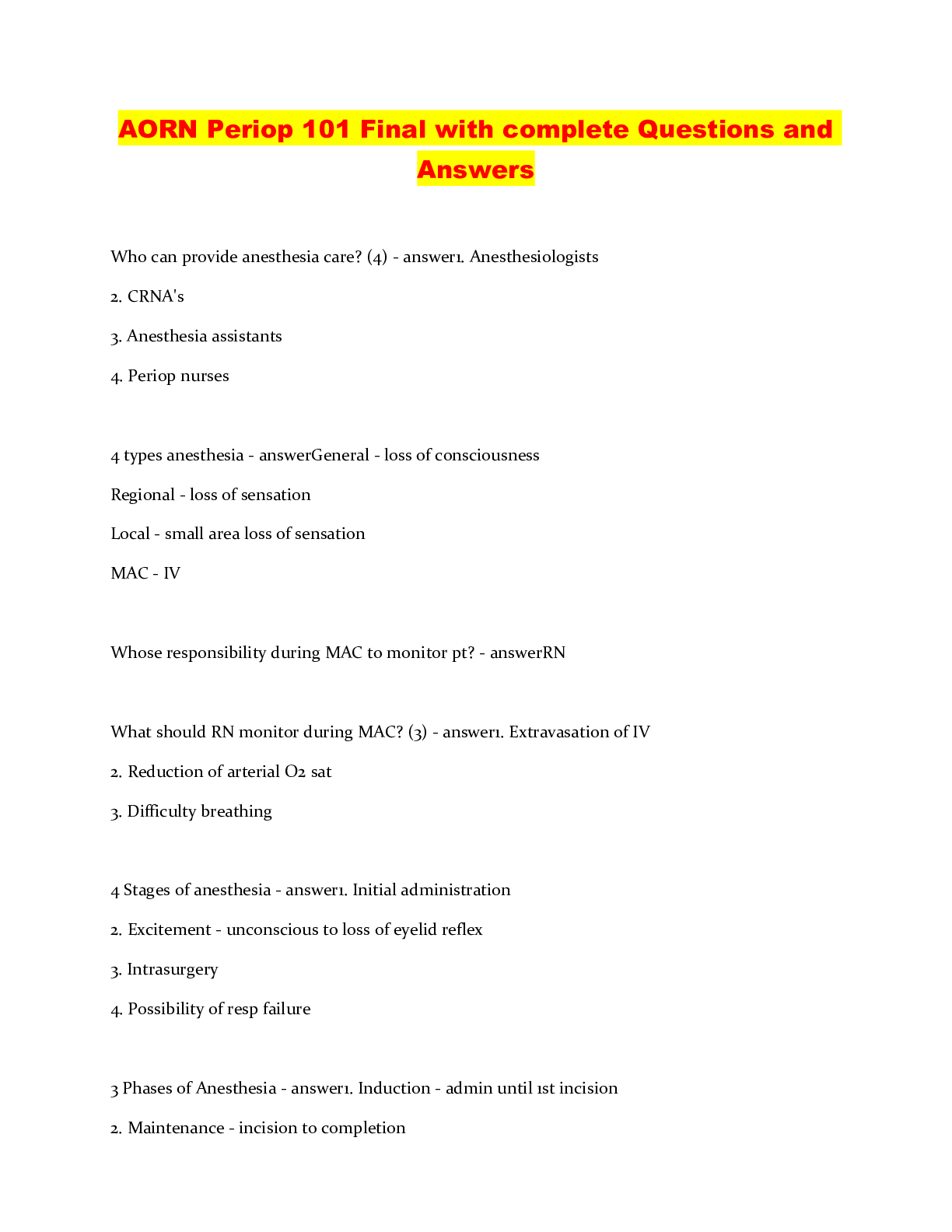Emergency Medicine > QUESTIONS & ANSWERS > EMT Practice Final Examination Top Questions and answers, 100% Accurate. (All)
EMT Practice Final Examination Top Questions and answers, 100% Accurate.
Document Content and Description Below
EMT Practice Final Examination Top Questions and answers, 100% Accurate. Snoring respirations are most rapidly managed by A. suctioning the oropharynx B. initiating assisted ventilations C. corr... ectly positioning the head D. inserting an oropharnygeal airway - ✔✔-correctly positioning the head Which of the following patients would be most in need of a rapid trauma assessment? A. an awake and alert 19-year-old man with a small caliber gunshot wound to the abdomen B. A conscious 25-year-old woman who fell 12' from a roof and landed on her side C. A 43-year-old woman with a unilaterally swollen, painful deformity of the femur D. a 60-year old man who fell from a standing position and has an abrasion on his check - ✔✔-an awake and alert 19-year-old man with a small caliber gunshot wound to the abdomen Which of the following bones is affected with a swollen, painful deformity to the lateral bone of the left forearm? A. Ulna B. Radius C. Clavicle D. Humerus - ✔✔-Radius During your assessment of a 34-year old man with a gunshot wound to the chest, you note that his skin is pale. This finding is most likely caused by A. a critically low blood pressure B. increased blood flow to the skin C. decreased blood flow to the skin D. peripheral dilation of the vasculature - ✔✔-decreased blood flow to the skin An 80-year old woman has pain in the right upper quadrant of her abdomen and a yellowish tinge to her skin. You should suspect dysfunction of the A. liver B. spleen C. pancreas D. gallbladder - ✔✔-liver Which of the following situations is an example of abandonment? A. An EMT--Paramedic givers a verbal report to any emergency nurse. B. An EMT--Intermediate assumes patient care from an EMT-Basic C. An EMT--Basic transfers care of a patient to patient to an EMT-Paramedic D. A first responder assumes patient care from an EMT-Intermediate - ✔✔-A first responder assumes patient care from an EMT-Intermediate Which artery should you palpate when assessing for a pulse in an unresponsive 6-month old patient? A. Radial B. Carotid C. Femoral D. Brachial - ✔✔-Brachial During the initial assessment of a trauma patient, you note massive facial injuries, weak radial pulses, and clammy skin. What should be your most immediate concern? A. Potential obstruction of the airway B. Internal bleeding and severe shock C. Applying 100% supplemental oxygen D. Providing rapid transport to a trauma center - ✔✔-Potential obstruction of the airway You are called to treat a male patient who overdosed on heroin and and is unconscious with shallow breathing and cyanosis to the face. The patient suddenly begins to vomit. What should you do first? A. Suction the oropharynx B. Turn the patient onto his side. C. Insert an oropharyngeal airway. D. Assist ventilations with 100% oxygen. - ✔✔-Turn the patient onto his side. The scene size up includes all of the following components, EXCEPT A. determining scene safety B. applying personal protective gear C. assessing the need for assistance D. evaluating the mechanism of injury - ✔✔-applying personal protective gear In which of the following patients would an oropharyngeal airway be indicated? A. Any patient suspected of having hypoxia B. A semiconscious patient with an intact gag reflex C. A semiconscious patient who took an overdose of propoxyphene D. An unconscious patient with fluid drainage from the ears - ✔✔-An unconscious patient with fluid drainage from the ears Upon arriving at the scene of a multiple vehicle crash, you can see that at least two patients have been ejected from their vehicles. What should you do next? A. Begin triage B. Treat the most critical patient first C. Gather all of the patients together D. Call for at least one more ambulance - ✔✔-Call for at least one more ambulance A 75 year old man has generalized weakness and chest pain. He has a bottle of prescribed nitroglycerin and he states that he has not taken any of his medication. After initiating oxygen therapy, you should next A. apply the AED and prepare the patient for immediate transport B. perform a detailed physical examination to located any other problems. C. contact medical control for permission to assist the patient with his nitroglycerin. D. complete a focused physical examination, including obtaining baseline vital signs. - ✔✔-complete a focused physical examination, including obtaining baseline vital signs. Which of the following organs is not part of the endocrine system? A. Thyroid B. Pituitary C. Pancreas D. Gallbladder - ✔✔-Gallbladder Which of the following injuries or conditions should be managed first? A. Fluid drainage from both ears B. Bleeding within the oral cavity C. A large open abdominal wound D. Bilateral fractures of the femurs - ✔✔-Bleeding within the oral cavity You arrive at a residence where you find a man lying unconscious in his front yard. There were no witnesses to the event that caused the unconsciousness. In assessing this man, you must assume that he A. has sustained an injury B. is having a heart attack C. is having a diabetic reaction D. is having a heat-related emergency - ✔✔-has sustained an injury When is the best time to perform a detailed physical examination? A. While enroute to the hospital B. After all life threats have been ruled out C. Immediately after taking baseline vital signs D. Following the initial assessment of a trauma patient. - ✔✔-While enroute to the hospital Which of the following conditions would most likely cause flushed skin? A. Shock B. Hypoxia C. Exposure to heat D. Low blood pressure - ✔✔-Exposure to heat During the rapid trauma assessment of a patient with multiple injuries, you expose the chest and find an open wound with blood bubbling from it. What should you do next? A. Apply 100% supplemental oxygen. B. Provide rapid transport to the hospital C. Prevent air from entering the wound. D. Place a porous dressing over the wound. - ✔✔-Prevent air from entering the wound. You are called to a local park for a 7-year old boy with respiratory distress. During your assessment, you find that the patient is wheezing and has wide-spread hives and facial edema. What should you suspect has occurred? A. Heat emergency B. allergic reaction C. Acute asthma attack D. Exposure to a poisonous plant - ✔✔-allergic reaction A common side effect of nitroglycerin is A. nausea B. headache C. hypertension D. chest discomfort - ✔✔-headache As you assess a 56-year old man, you note that he is pulseless and apneic. As your partner gets the AED from the ambulance, you should A. obtain a medical history from the wife. B. place the patient in the recovery position C. perform CPR until the AED is ready to use D. conduct a detailed examination of the patient. - ✔✔-perform CPR until the AED is ready to use Prescribed inhalers, such as albuterol (Ventolin), relieve respiratory distress by A. constricting the bronchioles in the lungs. B. contracting the smaller airways in the lungs. C. relaxing the smooth muscle of the bronchioles. D. dilating the large mainstem bronchi of the airway. - ✔✔-relaxing the smooth muscle of the bronchioles. In a patient with cardiac compromise, you would be LEAST likely to encounter A. anxiety B. dyspnea C. headache D. chest pain - ✔✔-headache When monitoring a patient with a head injury, the most reliable indicator of his or her condition is the A. pupillary reaction B. level of consciousness C. systolic blood pressure D. rate and depth of breathing - ✔✔-level of consciousness A 56-year-old man with a history of cardiac problems reports pain in the upper midabdominal area. This region of the abdomen is called the A. peritoneum B. epigastrium C. mediastinum D. retroperitoneum - ✔✔-epigastrium Which of the following mechanisms cause respiratory and circulatory collapse during anaphylactic shock? A. Bronchodilation and vasodilation B. Bronchodilation and vasoconstriction C. Bronchoconstriction and vasodilation D. Bronchoconstriction and vasoconstriction - ✔✔-Bronchoconstriction and vasodilation In the patient with diabetes, hypoglycemia typically presents with A. dry skin and a slow onset B. dry skin and a rapid onset C. clammy skin and a slow onset D. clammy skin and a rapid onset - ✔✔-clammy skin and a rapid onset Which of the following signs would LEAST suggest a diabetic emergency? A. Bradycardia B. Tachycardia C. Combativeness D. Fruity breath odor - ✔✔-Bradycardia Which of the following patients would be at most risk for suicide? A. A woman who quit her job for one that pays more B. A man who is in the midst of losing a significant relationship C. A man who is planning a family trip, but gets called away to work D. An EMT who saved a drowning child and receives a lot of media attention - ✔✔-A man who is in the midst of losing a significant relationship A middle-aged woman has acute shortness of breath and respirations of 30 breath/min. How should you first manage this patient? A. Assess respiratory quality B. Begin assisting ventilations. C. Apply supplemental oxygen D. Perform a detailed examination - ✔✔-Assess respiratory quality To obtain the most reliable assessment of a patient's tidal volume, you should A. assess for retractions B. listen for airway noises C. count the respiratory rate D. look at the rise of the chest - ✔✔-look at the rise of the chest As you are performing CPR on an elderly man, his wife presents you with a "do not resuscitate" order. Your most appropriate course of action is to A. ignore the document and continue the CPR B. comply with the document and stop CPR C. continue CPR until medical control is notified D. withhold CPR until medical control validates the order - ✔✔-continue CPR until medical control is notified A 5 year old boy complains of pain to the right lower quadrant of his abdomen. Correct assessment of this child's abdomen includes A. avoiding palpation of the abdomen B. palpating the left upper quadrant first C. auscultating bowel sounds for 2 minutes D. palpating the right lower quadrant first - ✔✔-palpating the left upper quadrant first In most states; the EMT-Basic is required to report which of the following occurrences? A. Animal bite B. drug overdose C. Injury to a minor D. Motor vehicle crash - ✔✔-Animal bite A set of regulations and ethical considerations that define the extent or limits of an EMT-Basic's job is called A. a duty to act B. confidentiality C. scope of practice D. the Medical Practices Act (??? can't read this for sure) - ✔✔-scope of practice A 9-year-old girl was struck by a car while she was crossing the street and is displaying signs of shock. During your assessment, you note a large contusion over the left upper quadrant of her abdomen. Which of the following organs has most likely been injured? A. Liver B. Kidney C. Spleen D. Pancreas - ✔✔-Spleen The automated external defibrillator (AED) should NOT be used in patients who A. are between 1 and 8 years of age B. experienced a witnessed cardiac arrest C. are apneic and have a weak carotid pulse D. have a nitroglycerin patch applied to the skin - ✔✔-are apneic and have a weak carotid pulse As you step out of the ambulance at the scene of a nighttime motor vehicle crash on the highway, your immediate concern should be A. oncoming traffic B. whether the car will catch on fire C. placing safety flares by the ambulance D. quick assessment of the patients in the car - ✔✔-oncoming traffic Which of the following actions should be carried out during the initial assessment of an unconscious patient? A. Assessing the skin B. Palpating the cranium C. Auscultating the lungs D. Obtaining a blood pressure - ✔✔-Assessing the skin You arrive at the scene shortly after a 55-year-old man collapsed. Two bystanders are performing CPR. The man's wife states that he had cardiac by-pass surgery approximately 6 months earlier. There are no signs of trauma. Your first action in the management of this patient should be to A. attach an AED and analyze the cardiac rhythm. B. check the effectiveness of the CPR in progress. C. insert an oropharyngeal airway and continue CPR D. stop CPR so you can assess pulse and breathing - ✔✔-stop CPR so you can assess pulse and breathing You arrive at the scene shortly after a 55-year-old man collapsed. Two bystanders are performing CPR. The man's wife states that he had cardiac by-pass surgery approximately 6 months earlier. There are no signs of trauma. Cardiac arrest in the adult population is most often the result of A. an acute stroke B. respiratory failure C. cardiac arrhythmias D. myocardial infarction - ✔✔-cardiac arrhythmias You arrive at the scene shortly after a 55-year-old man collapsed. Two bystanders are performing CPR. The man's wife states that he had cardiac by-pass surgery approximately 6 months earlier. There are no signs of trauma. After you attach the AED and analyze this patient's heart rhythm, the machine states, "shock advised." What cardiac rhythm is the patient most likely in? A. Asystole B. Ventricular fibrillation C. Ventricular tachycardia D. Pulseless electrical activity - ✔✔-Ventricular fibrillation Immediately upon delivery of a newborn's head, you should first A. dry the face B. cover the eyes C. suction the nose D. suction the mouth - ✔✔-suction the mouth You assess a newborn with cyanosis to the chest and face and a heart rate of 90 beats/min. What should you do next? A. Resuction the mouth. B. Briskly dry off the infant. C. Begin chest compressions D. Begin artificial ventilations - ✔✔-Begin artificial ventilations An EMT-B's failure to obtain consent to treat a patient could result in allegations of A. battery B. negligence C. abandonment D. breach of duty - ✔✔-battery Which of the following describe the MOST appropriate method of performing chest compressions on an adult patient in cardiac arrest? A. Compress the chest to a depth of 1 1/2" to 2", allow full recoil of the chest after each compression, minimize interruptions in chest compressions. B. Allow full recoil of the chest after each compression, compress the chest to a depth of 2", deliver compressions at a rate of at least 80/min C. Do not interrupt chest compressions for any reason, compress the chest to a depth of 1 1/2" to 2", allow partial recoil of the chest after each compression D. Minimize interruptions in chest compressions, provide 70% compression time and 30% relaxation time, deliver compressions at a rate of 100/min - ✔✔-Compress the chest to a depth of 1 1/2" to 2", allow full recoil of the chest after each compression, minimize interruptions in chest compressions Prevention of cardiac arrest in infants and small children should focus primarily on A. keeping the child warm B. avoiding upsetting the child C. providing immediate transport D. providing airway management - ✔✔-providing airway management You are managing a conscious patient who you believe is having an acute ischemic stroke. After administering oxygen, your next priority should include: A. providing prompt transport for possible fibrinolytic therapy. B. determining whether the patient has prescribed nitroglycerin C. closely monitoring the blood pressure D. completing a detailed physical examination before providing transport. - ✔✔-providing prompt transport for possible fibrinolytic therapy. Which of the following patients with diabetes should receive oral glucose? A. A confused patient who has cool, clammy skin B. A confused patient who has suspected C. A semiconscious patient with pale skin D. An unconscious patient who took too much insulin - ✔✔-A confused patient who has cool, clammy skin During a bar fight, a 22-year old man was stabbed in the chest with a large knife. The patient is pulseless and apneic, and the knife is impaled in the center of his chest. management should include A. stabilizing the knife, starting CPR, and providing rapid transport B. stabilizing the knife, applying an occlusive dressing and providing rapid transport C. removing the knife, starting CPR, and providing rapid transport D. removing the knife, applying an occlusive dressing, and providing rapid transport. - ✔✔-removing the knife, starting CPR, and providing rapid transpor [Show More]
Last updated: 1 year ago
Preview 1 out of 43 pages
Instant download

Instant download
Reviews( 0 )
Document information
Connected school, study & course
About the document
Uploaded On
Mar 15, 2023
Number of pages
43
Written in
Additional information
This document has been written for:
Uploaded
Mar 15, 2023
Downloads
0
Views
68






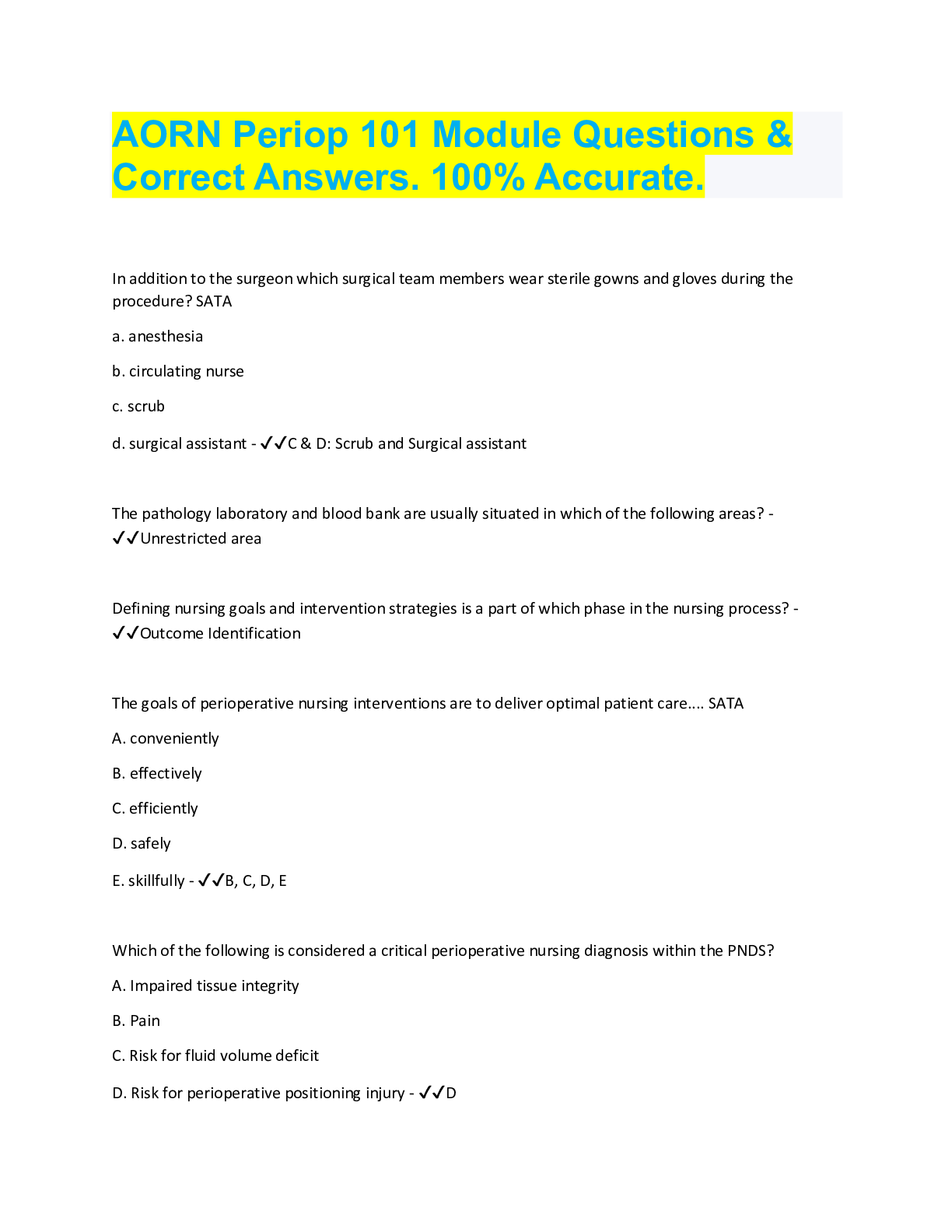





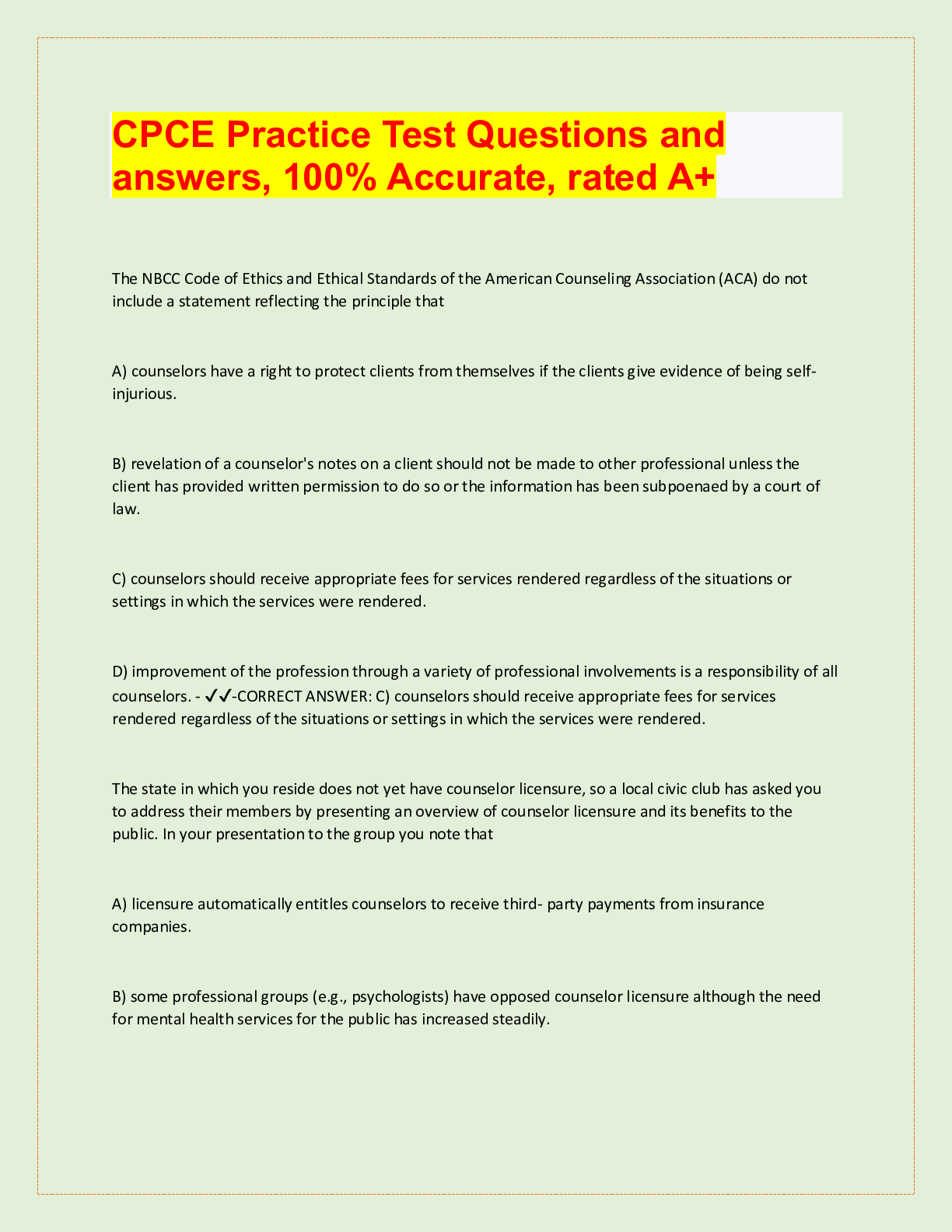


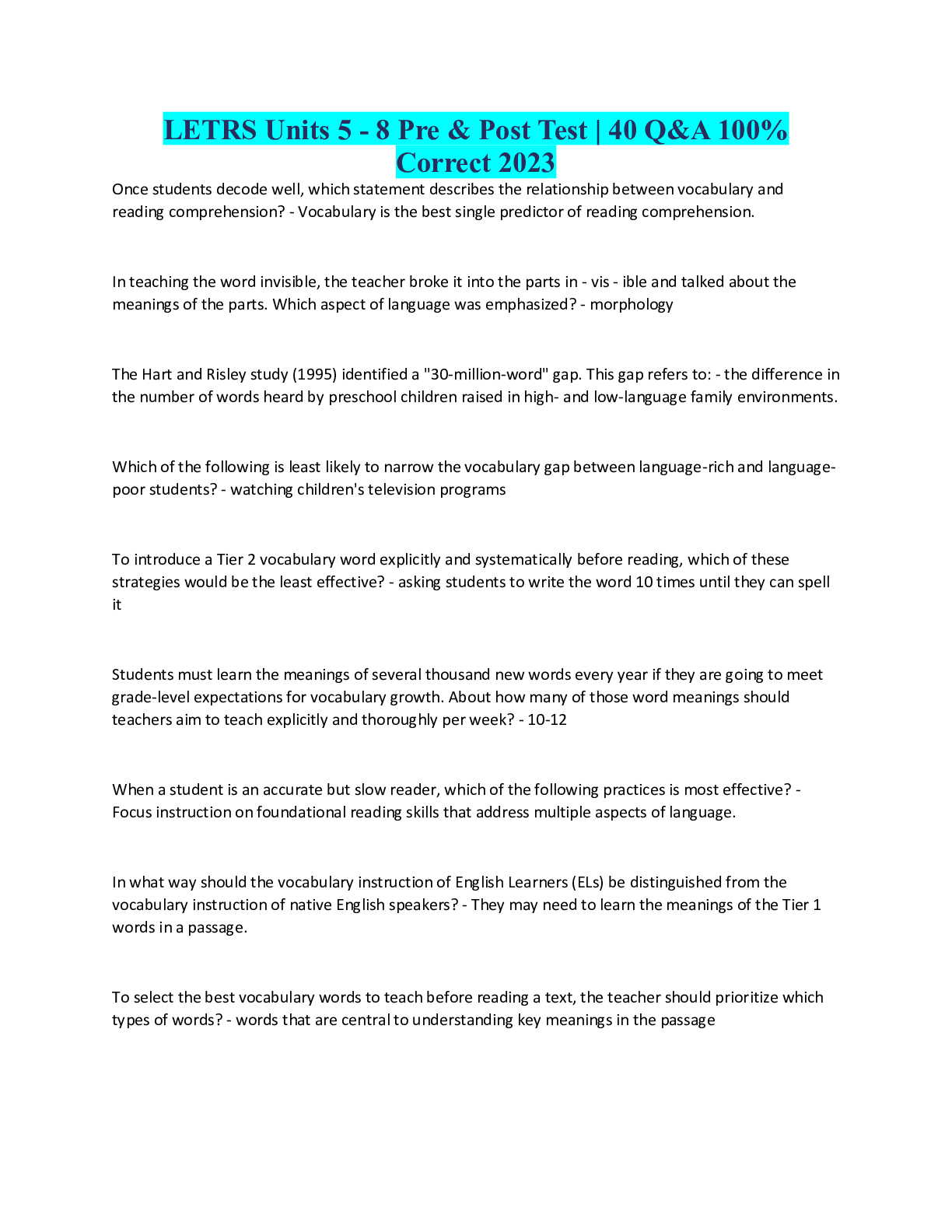
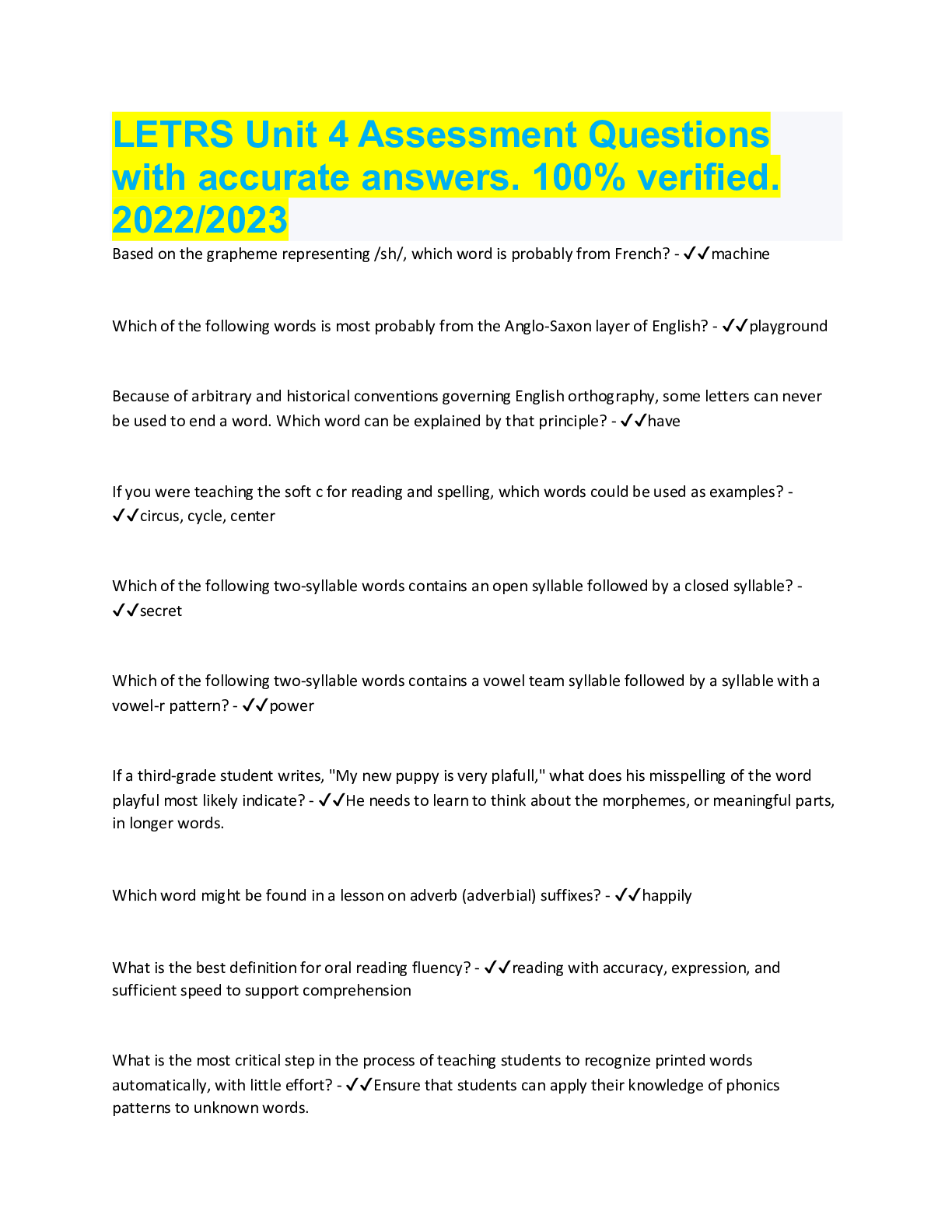



.png)
.png)
.png)



.png)
.png)
.png)
.png)
.png)


